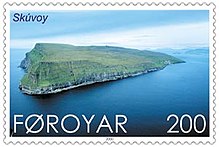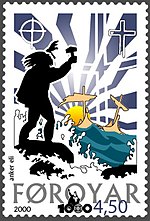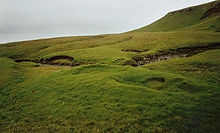Skuvoy
Skúvoy (Danish: Skuø) is an island belonging to the Faroe Islands archipelago, in the Norwegian Sea. Its only population center is the small town of Skúvoy, with 37 inhabitants (2011). Skúvoy is also the name of one of the 30 Faroese municipalities, which includes the island of the same name and the neighboring Stóra Dímun and is inhabited by a total of 45 people (2011).
Its name means 'skua island', and comes from the Faroese word skúgvur, the local name for the great skua (Catharacta skua), sea bird that has an important colony on the island.
In fact, the term "skua" It has its origin in the Faroese skügver ("tuft of feathers"). It is very aggressive and even dangerous, capable of viciously attacking and pecking at humans who enter its nesting territory. Even so, during the first week of June, it is traditional to collect the eggs of these animals, which are part of the typical gastronomy of the area.
Geography

Skúvoy is a small island of 12 km² (the fifth smallest) in the south of the Faroe Islands. It is located just over 3 km from the coast of Sandoy, the nearest island, in the strait known as Skúvoyarfjørður; 4 km from Stóra Dímun, from which it is separated by the Dímunafjørður, and 12 km from Suðuroy.
The relief is very steep. The highest points on the island are the peaks Knúkur (392 m) and Heyggjurin Mikli (391 m). Along the western coast there are cliffs 300 to 400 m high, where there are abundant colonies of seabirds. The northeastern coast, where the town is located, is less rugged, with some low-lying cliffs.
There are several water courses. All of them originate in the western mountains and flow into the eastern coast, the largest being the Botnsá, which runs through the town. In the center of the island there is a small lake.
History

The island is already mentioned in the Saga of the Faroese, a document written in Iceland in the century. XII. Skúvoy was the birthplace of Beinir and Brestir Sigmundsson, Viking chieftains who came to dominate half of the Faroe Islands in the 10th century. Brestir's son, Sigmundur Brestisson, was the leader who introduced Christianity to the archipelago in 999. Since then, the village of Skúvoy has had its own church. Sigmundur's grave is preserved in the town cemetery, and is marked with a rock with a cross carved into it.
Another historical event that had a great impact on the island was the Black Death. Tradition says that all the inhabitants died from this disease in the 14th century, except for a young woman named Rannvá., who did not live in the village, whose hut (Rannvátoftir) is preserved even today in the Fagradalur valley in the north of the island.
In the 18th century another disease, smallpox, decimated the island's population.
In 1930 Skúvoy, together with Stóra Dímun, constituted an independent municipality, splitting off from the municipality of Sandur, which until then included the islands of Sandoy, Skúvoy and Stóra Dímun.
Since December 2001 Skúvoy has been part of the Association of Outlying Islands (Útoyggjafelagið), which aims to develop eight small islands that share serious problems: isolation, depopulation, small economy and few opportunities.
Infrastructure
There are no roads on the island, as there are no cars, only some agricultural vehicles. Skúvoy is connected to the village of Sandur in Sandoy by a small ferry, and to Tórshavn by a helicopter service. The port is small and can only be visited by small draft ships.
The town has a primary school, shop and post office, but there is no restaurant or hotel.
Sites of historical interest

The small church dates back to 1937, and is the successor to another that was built in 1852 in the same place.
In the cemetery is the tomb of the Viking chief Sigmund Brestisson, who introduced Christianity to the Faroe Islands. His grave is marked by a rock with a chiseled cross, and is one of the most significant medieval monuments on the islands.
In the Fagradalur valley, 3 km north of the town, are the ruins of the hut of Rannvá, the only person to survive the black plague epidemic of the century XIV. Although the ruin is covered with grass, the remains of the walls are still visible.
The artist Hans Pauli Olsen erected a monument to Sigmundur Brestisson next to the Skúvoy church on the occasion of the 1000th anniversary of the Christianization of the Faroe Islands.
The municipality of Skúvoy

Skúvoy is one of the 30 municipalities of the Faroe Islands, and its territory includes, in addition to the island of the same name, the neighboring island of Stóra Dímun.
In terms of population, the municipality of Skúvoy has only 45 inhabitants, being the second least populated of the islands, after Fugloy. It has two towns, the largest being the town of Skúvoy, while the town of Stóra Dímun is barely inhabited by a single family.
| Locality | Hab. |
|---|---|
| Skúvoy | 37 |
| Stóra Dímun | 8 |
| TOTAL | 45 |
The municipality of Skúvoy is governed at the local level by a municipal council headed by the mayor. Due to the small population, in recent years the council has been made up of only 3 people. The mayor for the period 2009-2012 is Harry Jensen.
Contenido relacionado
USA (disambiguation)
Cordova
Ischaemum